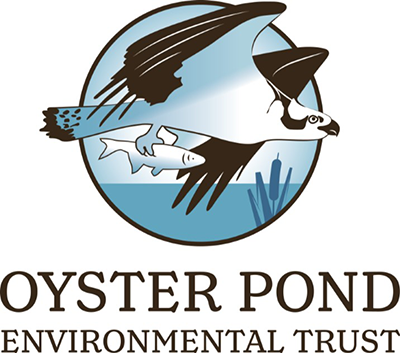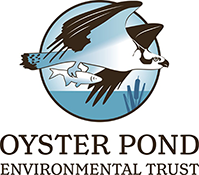Ways to Help
There are many ways you can help Oyster Pond.
Below are some suggestions of things you can do to improve the water quality of Oyster Pond. Send us suggestions at info@opet.org if you have any other ideas!
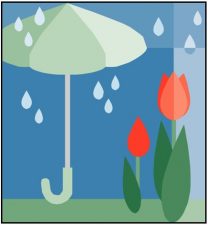
Limit the Amount of Storm Water Runoff from your Property
Storm water runoff is one of the major pollutants to Oyster Pond. Storm water coming off roof tops, driveways, gardens and streets picks up a variety of contaminants. It is a nasty brew of salt, automotive chemicals, metals, grease, garden chemicals, animal waste, dust and dirt that flows unimpeded into the pond. Contaminants harm fish and other aquatic life and increase nutrient levels. Sediments carried in storm runoff can smother aquatic life, clog fish gills, and cut off the light needed by underwater plants. If each property owner limited storm water runoff from their property this would limit the amount of this toxic brew entering our Pond.
How: Divert rain gutters from paved surfaces to grass or other vegetated areas. Install a rain barrel to collect precipitation. Replace impervious surfaces such as concrete with brick or paving stones that allow precipitation to run between pavers. Reduce the amount of lawn and replace with trees and other vegetation that absorb more precipitation. Install gravel trenches along your driveway to collect runoff or consider installing a rain garden to collect runoff from your site. See more information on our Stormwater page.
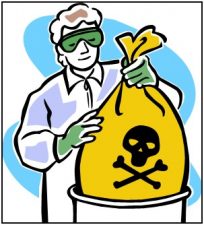
Dispose of Toxic Chemicals at the Household Hazardous Products Collections
Do not dump toxic chemicals in the ground, ditch or storm drain. They can flow directly into the pond or Vineyard Sound. Never dump toxic chemicals down your drain as they can damage your septic system and migrate through the groundwater to Oyster Pond. Read the labels of your household products; even some common household cleaners contain harmful ingredients such as dichlorobenzene (mold or mildew control products) or petroleum distillates (furniture polish, paint thinners). If you live in a flood zone keep all toxic hazardous materials in secure cabinets above potential flood waters to prevent contaminants washing into Oyster Pond during storm events.
How: Household Hazardous Product Collections are held every year from April through October at each of the four Upper Cape Towns. There are also options for year round safe disposal of household hazardous waste for Barnstable County. The County suggests you conduct a Household Hazardous Waste Audit of your home. They also have extensive instructions on how to dispose of common household hazardous waste such as yard chemicals, paint, and medications. Additionally, consider switching to Eco-friendly products instead of using toxic chemicals. For additional information about Barnstable County’s Hazardous Waste Disposal contact : Kalliope Chute, Hazardous Materials Environmental Specialist, 508-375-6699, kalliope@barnstablecounty.org

Have a lush lawn without nitrogen fertilizer
Using fertilizer wisely on your lawn is another way home owners can help Oyster Pond. The Massachusetts Estuaries Project calculates about 10% of the nitrogen harming our estuaries comes from fertilizer! The Town of Falmouth enacted a Nitrogen Control Bylaw to guide homeowners as to the best practices for growing a healthy lawn while protecting our waterbodies.
Key provisions of the Bylaw:
- Don’t fertilize your lawn between October 16th and April 14th or before or during a heavy rain event.
- Don’t fertilize any lawn located within 100’ of wetlands or waterbodies.
- Avoid spreading fertilizer on paved surfaces; sweep it up if you do.
- For lawns outside of the 100’ prohibited zone, use organic fertilizer sparingly.
How:
- Leave grass clippings on lawn – the best and easiest source of nitrogen for your lawn!
- Top dress with organic compost to build up to an ideal 6” of topsoil; if you don’t have it, add 1/4″ to 1/2″ of loam or compost top dressing every year.
- Seed with a mix of native grasses, fescues and perennial rye grasses. No Kentucky Bluegrass for the Cape.
- Learn to use de-thatching, aeration, and overseeding to encourage thick, healthy turf that defeats weeds and pests.
- Keep grass at least 3” tall – high grass shades out weeds.
- Mow with sharp blades – prevents the introduction of diseases into torn turf.
- Only water deeply once a week (1″ each week) – this encourages longer grass roots and more drought tolerant turf.
- Soil should have a pH level of 6.5-7.0. Modify as appropriate to reach this level.
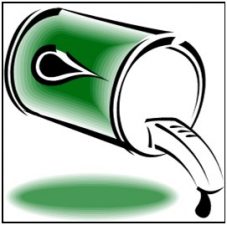
Recycle Used Motor Oil, Batteries and Anti-Freeze
Never, ever dump used oil into the ground or storm drains. According to the EPA, used motor oil is the single largest source of water pollution to lakes, streams and rivers. The oil from one engine can produce an eight acre oil slick. Another problem is the motor engine oil that drips on driveways and streets. Precipitation washes this oil debris down streets into the Pond. Used motor oil is not accepted at the Hazardous Product Collections.
How: Used motor oil is accepted at the Town Waste Management Facility at 458 Thomas Landers Rd. The oil tank is across from the trailer in front of gate to the facility. Check with the gatekeeper before disposing. A dump sticker is not required nor is there a fee. Also, use drip pans or ground cloths to catch drips from motor engines to prevent oil from being washed into stormwater run-off. You can also dispose of batteries and anti-freeze at the same location.

Maintain a Vegetated Buffer along the Pond’s Shoreline
Keeping buffers along the shoreline is one of the most important things we can do to maintain a healthy ecosystem around the pond. These buffers serve many important functions by intercepting fertilizer and pesticide runoff, stabilizing soils, preventing shoreline erosion and providing habitat to birds, amphibians and animals in the important zone between land and water. Trees and shrubs provide cooling shade along the shoreline for fish and other aquatic dwellers. Woody debris from fallen limbs provides important habitat. Lawns down to the water’s edge are not good for the pond. Lawns are ecosystem deserts. They lack biodiversity and offer neither shelter nor a food source to animals. If you can, please limit the size of your lawn and replant it with native plants instead.
How: Let natural vegetation grow along the shoreline. If your area was cleared, consider planting native plants to replace the lost natural buffer. The Association to Preserve Cape Cod has a list of native plants that do well in our climate. Remember to contact the Con Com prior to any work along the banks and shoreline and within 100 feet of the edge of the Pond, even vista pruning.
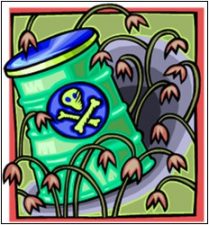
Avoid the use of pesticides on your lawn and in your garden
Pesticides can run off our gardens and lawns during rainstorms and enter Oyster Pond. The toxins in pesticides contain ingredients that are harmful to fish, birds and wildlife. Many chemicals are especially harmful to fish and other aquatic dwellers. Consider for example, the “weed and feed” lawn chemicals applied to lawns in the spring. Most contain the toxic pesticide 2,4-D that can be acutely toxic to fish depending on the formula. Studies also found it bio accumulates in some fish and is highly toxic to benthic animals.
How: Many garden centers now have environmentally friendly alternatives. For a “green” weed and feed lawn product consider using corn gluten; it suppresses seed formation while fertilizing your lawn. Spread in early spring, about when the forsythia bloom. It only works to prevent weed seeds from forming roots. It does not control existing weeds. Therefore, carefully evaluate what your lawn may need. Also be aware that corn gluten needs a drying period of several days so avoid applications before a rainy forecast. It is available from several different manufacturers and at local garden centers.

Do not flush pharmaceuticals down your toilet!
For many years the public was told to dispose of expired pharmaceuticals down the toilet or liquid medications down the sink. Now, according to studies by the Silent Spring Institute (speakers at OPET’s annual meeting), these drugs and other personal care products enter the groundwater via our septic systems and migrate to our ponds and estuaries. Oyster Pond was one of the study sites and contains higher levels of these pollutants than less populated watersheds on Cape Cod. Other studies found residues of pharmaceuticals in fish, including medicines used to treat high cholesterol, allergies, high blood pressure, bipolar disorder and depression. Very low levels of these chemicals are found to cause the feminization of fish and other reproductive problems.
How: Watch for the Drug Take Back Days sponsored by the Falmouth Police. They provide a safe box for disposing of your unwanted/unused prescriptions. Check to see if your pharmacy will take back expired or unused medication. Another option is to remove unused, unneeded, or expired prescription drugs from their original containers and throw them into the trash. If you are concerned about accidental poisoning or drug abuse, mix them with coffee grounds or other undesirable products and seal in a nondescript impermeable container before tossing into the garbage. Barnstable County has additional information about safe drug disposal.
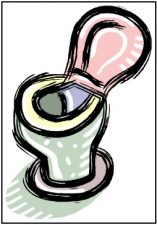
Regularly pump out your septic system
All septic systems must be pumped every 3 to 5 years to remove the sludge and floating scum to prevent the system from failing. Avoid flushing chemicals and bleach products into your system as they can kill the bacteria that are an important component of a healthy septic system Don’t install or use a garbage disposal as the solids and grease stress the bacteria and shorten the life of the system.
How: Compost what organic waste you can and dispose of grease in the regular trash. Curbside compost pickup is now available in Falmouth for a fee. Set up a regular pump out timetable with your septic system hauler.
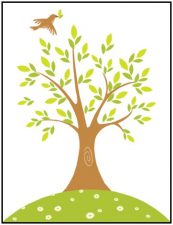
Recycle lawn clippings and leaves
Leave lawn clippings on the lawn to break down and renourish your lawn. Clippings are a free and easy source of nitrogen for your lawn. Contrary to old folk tales, clippings do not cause thatch. Thatch is caused by excessive use of fertilizer. As for your fall leaves – use them in your garden! Rake leaves off your lawn into shrub and flower beds. Decomposing leaf litter is a great soil amendment. It releases nutrients into the soil and helps keep it moist, a valuable resource here on sandy Cape Cod. It also serves as great nesting material, hiding places and protected spots for animals. Many moths, such as the luna moth, and butterflies lay their eggs in the litter. Birds also depend on the insects, worms and snails that live in the litter. Do not dispose of lawn clippings or leaves in the pond or in wetlands. It is illegal to dump anything in a wetland area.
How: Compost leaves and clippings (if you still think you must take them off the lawn) at your property or take them to the Town’s compost facility where they are accepted for FREE. The facility is on 565 Blacksmith Shop Road (upper Gifford St.) and open Tuesday – Sat 7:45am to 3:00pm. You can also take away free compost.
